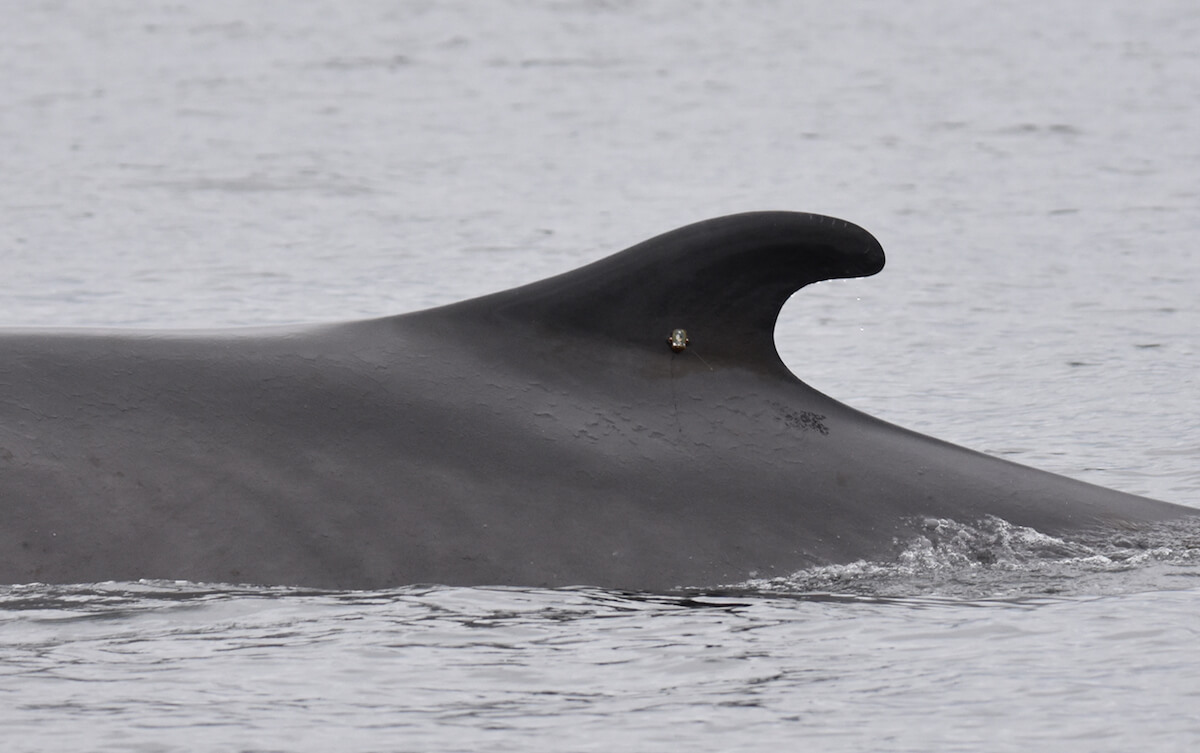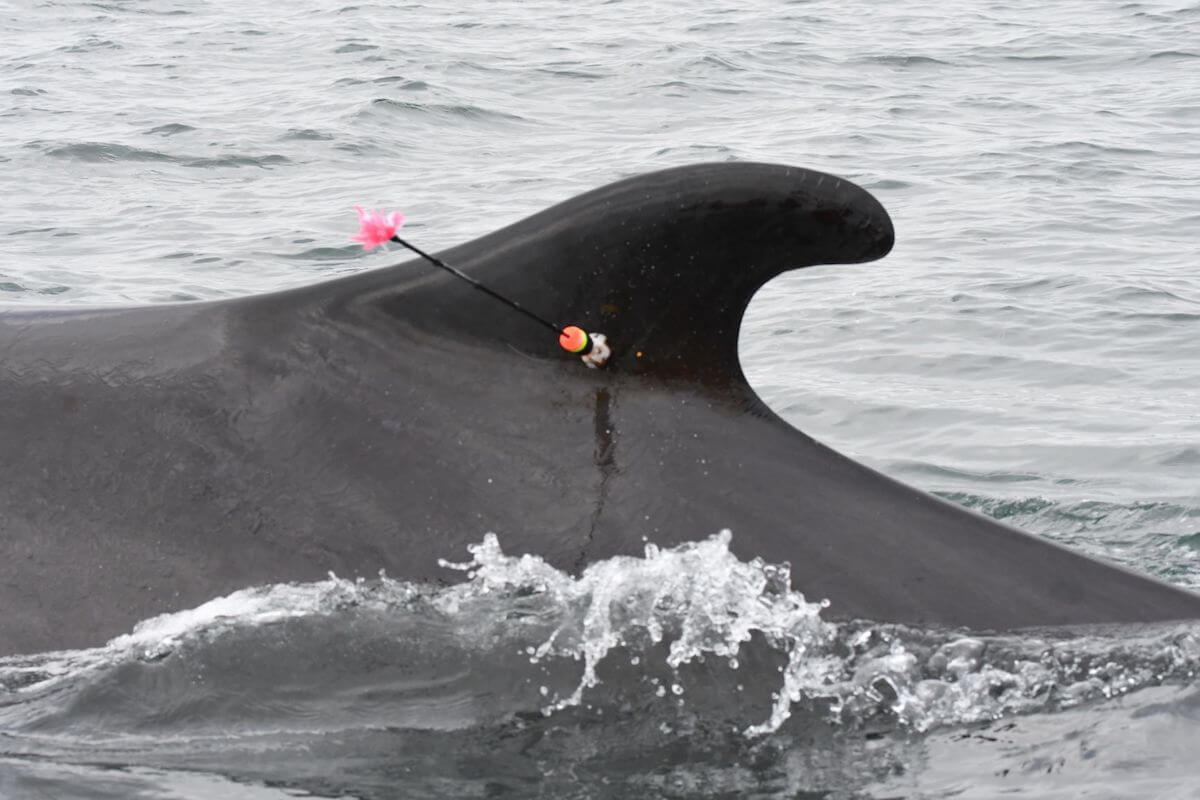The fin whale Bp955, a.k.a. “Ti-Croche”, has just revealed precious secrets on the migratory movements of its species. On October 5, Véronique Lesage, scientific researcher at the Maurice Lamontagne Institute of Fisheries and Oceans Canada, and her team managed to tag this well known individual in the Saguenay-St. Lawrence Marine Park. And for over three months, the scientist tracked the astonishing voyage of Ti-Croche, a journey that took this individual from the Estuary to the Bahamas via Bermuda, before returning to Nova Scotia. “This is the first time we ever followed a fin whale this long in the fall and winter,” she exclaims.
Where to spend the winter when you’re a fin whale?
“Current scientific literature contains little information on the wintering grounds of fin whales. We know the important feeding grounds in the St. Lawrence quite well, but for the rest, we know very little. Fisheries and Oceans Canada therefore wants to validate the expanse of the species’ playground in order to coordinate as necessary its protection measures with those of other concerned countries,” explains Véronique Lesage, who is also spearheading a project to understanding habitat use and seasonal movements in fin whales.
Thus, to better understand fin whale movements, scientists are tagging animals at two key times: in the fall, at the start of migration, and in the spring, when the intensive feeding period begins. Since 2014, twenty tags have been placed by experts from Fisheries and Oceans Canada in collaboration with researchers from the Mingan Island Cetacean Study, including nine in the fall of 2020. As of January 13, three tags were still transmitting positions. Almost every day, Argos-type tags emit a position. “At the present time, we are seeing that the playground of the fin whales that visit the St. Lawrence is even more immense and diverse than we thought. We also see that fin whales can travel impressive distances in a very short time,” notes Véronique Lesage.
Global, but also local understanding
Even within the St. Lawrence, which is relatively small when we look at the entire swath of sea and ocean covered by Ti-Croche, the tags provided interesting data. This past fall, the majority of fin whales were fitted with their tags in a small area off the coast of Cap de Bon-Désir that locals have nicknamed “the fin pit”. “In 2020, it seems that the ‘pit’ was THE spot for fin whales and possibly for humpbacks during a good part of the summer and fall throughout the Estuary and the western Gulf. Some of the tagged individuals left the ‘pit’ area and returned a few days later, suggesting that there must have been some benefit for the whales to be there,” indicates Véronique Lesage. “Additionally, our forays into other parts of the Estuary and the northwestern Gulf did not turn up any individuals.”
However, this sector is traversed by commercial vessels that elect to pass along the south shore, which puts fin whales at risk of collision and can disrupt their feeding. In a context where fin whales seem to have been showing reproductive issues since 2008, protecting sectors as attractive and critical for the species as “the pit” then becomes essential.
Movements, songs and isotopes to study a vast territory
One of the strong points of Véronique Lesage’s project is how it uses other types of data. For example, from photos taken by Fisheries and Oceans Canada, six individuals tagged in 2020 were identified by the team from the Group for Research and Education on Marine Mammals (yes, we prolong the suspense before revealing the other stars that were tracked!). Among them, Bp955, also known as Ti-Croche. Born in 2009, this fin whale is the descendant of another well-known fin whale, Capitaine Crochet (“Captain Hook” in French). At the current time, we do not know its sex, “but determining it could provide clues as to whether females and males share the same migratory habits. Since we know his or her age, at least we know that he or she is sexually mature,” notes Véronique Lesage. Indeed, sexual maturity occurs in males between the ages of 6 and 10 and in females between the ages of 7 and 12. “If Ti-Croche reappears in the Estuary next spring, it will be interesting to see if it is accompanied by a calf.”
Acoustic data might also revolutionize the way we think about fin whale migration. In recent years, various research organizations have been recording the sounds emitted by whales in the St. Lawrence, off the coasts of Newfoundland and Nova Scotia, as well as in the Atlantic. These efforts could reveal other information on migration, such as the presence of multiple populations of fin whales or an indication of a stronger presence in a given area during a given period.
Lastly, studying the gestation and migration cycles of fin whales based on the patterns of stable isotopes, hormones and mercury in the baleen of stranded animals of this species could shed new light on the variability of migrations between individuals. Baleen analysis can be used to track migrations after the fact, since each region of the ocean has its own characteristic levels of isotopes and mercury, and fin whale baleen can be a window into the last four or five years of the animal’s life. “We would be able to see, for example, whether there is a difference in migration patterns between males and females, or according to an individual’s age or the gestational state of females,” points out the researcher.
All of this work will take time and immense collaborative work, but the possibilities are already promising. Where will Ti-Croche go now? It seems to be lingering near the edge of the continental shelf, evidently a good place for foraging. Will it turn back south or make a beeline toward the middle of the ocean? Will it return to the Estuary with a calf? Its story certainly does not end here.









